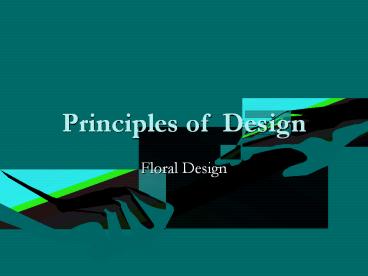Principles of Design - PowerPoint PPT Presentation
Title:
Principles of Design
Description:
Principles of Design Floral Design The Principles of Design are Focal Point Proportion Scale Balance Rhythm Harmony Unity Focal Point The center of interest in a ... – PowerPoint PPT presentation
Number of Views:278
Avg rating:3.0/5.0
Title: Principles of Design
1
Principles of Design
- Floral Design
2
The Principles of Design are
- Focal Point
- Proportion
- Scale
- Balance
- Rhythm
- Harmony
- Unity
3
Focal Point
- The center of interest in a design
- Draws the most attention and directs the viewers
eye to a specific location within a design. - Located slightly above the rim of the container
and extends slightly out in front of the
container to give depth.
4
Where is the Focal Point?
5
Proportion
- Concerns the relationship between the flowers,
foliage, and container. - To attain proper proportion
- Smallest flowers should be positioned at the top
and edges of the design and as you work towards
the focal point gradually increase the flower
size. - Plant material should be 1 ½ to 2 times the size
of the container
6
Proportion
- Do these arrangements achieve proper proportion?
7
Scale
- The relationship between the completed
arrangement and its location or surroundings. - Arrangement should fit in where it is placed.
- Example A small arrangement on a large table
shows improper scale.
8
In Scale or Out of Scale?
9
Balance
- Provides an arrangement with the impression of
being stable and self-supporting. - Gives visual weight to the arrangement and
makes it more pleasing to the eye. - Can have symmetrical balance or asymmetrical
balance
10
Symmetrical Balance
- Formally balanced
- Same on each side, appears to be an imaginary
vertical line running through the center of the
arrangement. - Passive and restful tone
11
Asymmetrical Balance
- Informal and more natural design.
- The two sides are completely different, but,
visual weight appears equal and balanced.
12
Overall Balance
- Top to Bottom
- The bulk of the weight should on the lower half
of the arrangement near the rim of the container
to achieve proper balance.
13
- Front to Back
- Smooth and gradual flow from the top flower to
the bottom outermost flowers. - Tip the top rear flower slightly backward to
produce depth and visual balance (flowers toward
the top should not lean over the flowers
positioned below).
14
Rhythm
- The apparent flow of lines, textures, and colors
that express a feeling of motion rather than
confusion. - Rhythm provides a sense of beauty.
- Can be achieved through repetition, radiation,
and transition.
15
Achieving Rhythm through Repetition
- Accomplished by repeating one or more of the
design elements such as color, line, pattern,
shape, space, or texture. - Repetition allows the eye to move smoothly from
one area to another so the viewer can see the
entire design.
16
(No Transcript)
17
Achieving Rhythm through Radiation
- Placing flowers with their stems originating from
the focal point so the flowers appear to radiate
from the center of the design.
18
Achieving Rhythm through Radiation
- Creates emphasis at the center of interest and
provides visual movement throughout the
arrangement. - Gives strong sense of unity and grace to
arrangement.
19
Achieving Rhythm through Transition
- Creates a sense of motion within the design that
leads the eye to the center of interest. - Produced by repeating similar shapes in a
systematic size progression or spacing identical
shapes in a systematic space gradiation to
achieve transition.
20
(No Transcript)
21
Harmony
- For harmony to be achieved, all the parts of the
design must be blended in a pleasing
relationship. - The flower shapes, colors, textures, and sizes
should fit together to express a central theme
or idea.
22
Unity
- Achieved when all parts of the design combine w/o
noticeable separation. - The arrangement should be a complete unit, not
just a group of flowers thrown together.































